Inside\Within is a constantly updating web archive devoted to physically exploring the creative spaces of Chicago's emerging and established artists.
Support for this project was provided by The Propeller Fund, a joint administrated grant from Threewalls and Gallery 400 at The University of Illinois at Chicago.

Search using the field below:
Or display posts from these tags:
3D printing 3D scanning 65 Grand 7/3 Split 8550 Ohio 96 ACRES A+D Gallery ACRE animation Art Institute of Chicago Arts Incubator Arts of Life audio blogging Brain Frame CAKE Carrie Secrist Gallery casting ceramics Chicago Artist Writers Chicago Artists Coalition Chicago Cultural Center Cleve Carney Art Gallery Clutch Gallery Cobalt Studio Coco River Fudge Street collage collection Columbia College Chicago Comfort Station comics conceptual art Contemporary Art Daily Corbett vs. Dempsey Creative Capital DCASE DePaul University design Devening Projects digital art Dock 6 Document drawing Duke University dye Elmhurst Art Museum EXPO Chicago Faber&Faber fashion fiber Field Museum film found objects GIF Graham Foundation graphic design Harold Washington College Hatch Hyde Park Art Center illustration Image File Press Imagists Important Projects ink installation International Museum of Surgical Science Iran Jane-Addams Hull House Museum jewelry Joan Flasch Artist's Book Collection Johalla Projects Julius Caesar Kavi Gupta Links Hall Lloyd Dobler LVL3 Mana Contemporary metalwork Millennium Park Minneapolis College of Art and Design Monique Meloche Museum of Contemporary Art Chicago (MCA) Museum of Contemporary Art Detroit (MOCAD) Museum of Contemporary Photography (MoCP) National Museum of Mexican Art (NMMA) National Resources Defense Council New Capital Northeastern Illinois University Northwestern University Ox-Bow painting paper mache Peanut Gallery peformance Peregrine Program performance photography PLHK poetry portraiture printmaking public art Public Collectors publications Renaissance Society risograph rituals Roman Susan Roots&Culture SAIC screen printing sculpture Sector 2337 Shane Campbell Silver Galleon Press Skowhegan Slow Smart Museum Soberscove Press social practice South of the Tracks Storefront SUB-MISSION Tan n' Loose Temporary Services Terrain Terrain Biennial text-based textile textiles The Banff Centre The Bindery Projects The Cultural Center The Franklin The Hills The Luminary The Packing Plant The Poetry Foundation The Poor Farm The School of the Art Institute of Chicago (SAIC) Threewalls Tracers Trinity College Trubble Club University of Chicago University of Illinois at Chicago (UIC) University of South Florida at Tampa Valerie Carberry Vermont Studio Center video weaving Western Exhibitions wood carving woodwork Yellow Book Yollocalli Arts Reach zinesInside\Within is produced in Chicago, IL.
Get in touch:
contactinsidewithin@gmail.com
Andrew Holmquist's Articulation Through Destruction
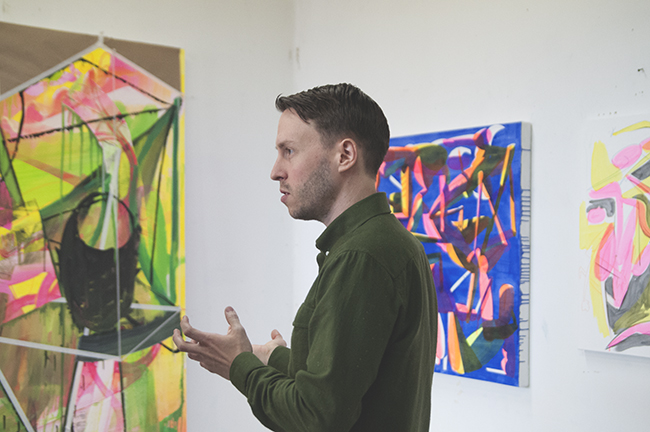
Embedded within Andrew’s work are the subtle and not so subtle instructions for its final composition. This process is also explored within his video work, 4-5 minute pieces that trace his compositional decisions while keeping a beat to move the audience along at a steady pace. Andrew’s work seduces the viewer into engaging longer than the typical once-over, making sure to entice one from any distance they stand from the canvas.
I\W: How do your paintings express the journey of getting to the final piece? How do they include both instructions for their making as well as the final product?
AH: I want the journey to be part of the narrative. Sometimes there are specific narratives evident in the work, but the metanarrative of the construction of the painting is often more the focus than a scenario I’ve created. I like to highlight the story of how the piece was made and the steps that went into it— letting elements hang out enough so you can still see through a mark even though it might be obscuring what is underneath. It is a process of building up, concealing, and leaving pockets for the audience to get a glimpse of the previous steps that helped the painting get to its final product.
Is your video work’s intention (like your piece “Painting, Time and Space”) to expose this painting process to the audience?
I suppose so. I guess the construct of that particular piece was painting, the process that I use, and the history that I am interested in. When I look at a painting I can unwind the steps that the artist used to get to the final product. That is something that takes a long time to figure out though, and I think it is rewarding once you can get there and be able to unlock those steps. I think for me the video was a way to articulate that a little more clearly to the audience—this sense of frozen time that is inherent to painting that you can also reanimate by looking at it and tracing the steps. My video work has been using painting as an organizational devise, but it also does things that painting cannot do. It is using that as a jumping off point.
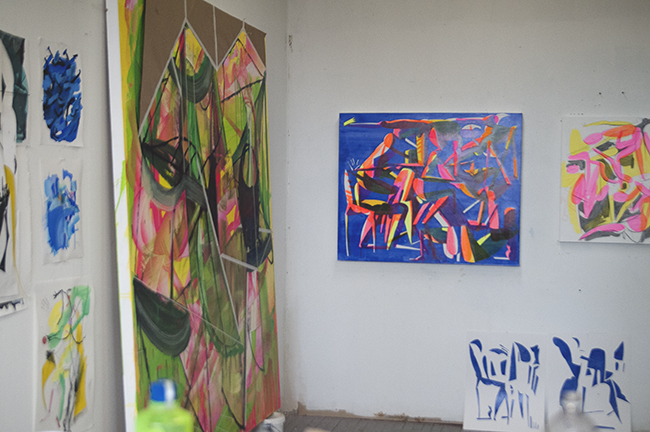
What does your video work do that your painting cannot?
I intentionally try to keep my videos short, in the 4-5 minute range, given the short attention span that I, and most people have. But even that relatively short amount of time is exponentially longer than most people will give a single painting. How many seconds do they say people look at a painting on average in a museum? Whatever the exact number is it’s low and depressing. The videos are an effective way to seduce people into a focused moment, especially if you keep the action clipping along with the tense promise of more to come—just wait! With this focus you can string together a sequence of events that can surprise, confuse, and make them laugh. Sure, you can be surprised and confused by a painting but it’s rare that a painting conjures actual belly laughs. As they say, timing is everything, and timing is certainly easier to control in a time-based medium. Focused attention and instant gratification is something these videos offer, versus a painting which you can spend years looking at in 30 second bursts and still be fed. It’s a trade-off in dynamics.
There is a shifting of light at the end of each of your videos that I found confusing but enjoyable. What is the reasoning behind this last minute switch after the composition freezes?
I was thinking of that in terms of cropping, masking, and painting a coat over a painting. It acts in the way that darkness edits out certain information and highlights other details. For a certain painting with a lot of neon it is only when dark blue gets added on top and lets through pockets of that glow that it gets to be a solid image. It is a way to cover up, but also clarify. I think in that video I was thinking about that glazing process I had been using.
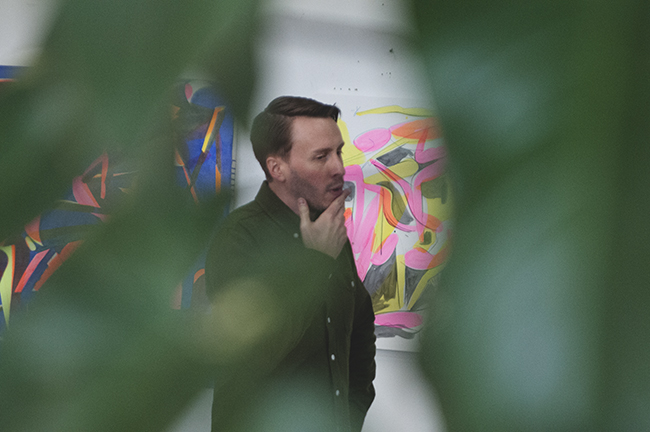
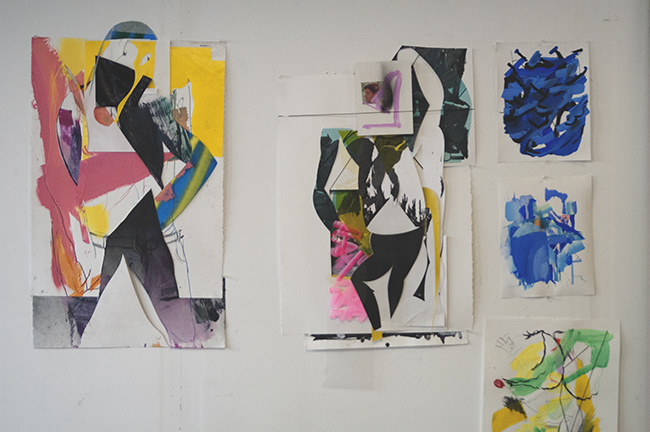
It’s difficult to make paintings look good digitally—to present that dimensionality you experience in person. How do you think about your own work in relation to the digital image? Is that something in your mind while painting?
I think of it in terms of distance, and it is important to me to have my paintings work with several different vantage points. How does the painting look from 40 feet away versus ten feet versus four feet versus one? All of these various spaces have different experiences and different things come into focus or take priority. At a distance it would be the graphic image of the painting. Up close you are going to get much more into the materials—it is a narrative hub of how the piece was made. The internet forces a fake distance from a work. You are always going to get that image quality, but the sculptural layering is reduced. As much as I want a painting to work at various distances, I also want it to work online. It is another space for my work to exist within.
“When you get up close you can see these things more clearly and then you link your hand to that hand and it places you all of a sudden on the flip side of the mirror. All of a sudden you are trapped on the other side of this portal. It is like a venus fly trap in a way.”
How do you want your works to converse with the body?
I want my paintings to hook people from a distance. I want them to get waved in—a friendly hello that brings you up close. Once you are up close you get trapped and stuck in this mud, this kind of controlled experience where I am dictating how you enter the space and move around it. This thing that seemed clear and playful at a distance is actually a trap up close. It almost has an aggression to it and is not going to let you go. I am not sure if aggression is the right word, but I want there to be this experience of you getting sucked into the painting when you are standing close to it. I have a painting that is more or less lifesize. The body parts buried underneath all of the painted layers are about lifesize too, and you can see hands and feet poking out. When you get up close you can see these things more clearly and then you link your hand to that hand and it places you all of a sudden on the flip side of the mirror. All of a sudden you are trapped on the other side of this portal. It is like a venus fly trap in a way.
How do you create bodies that rely more on personality or attitude than just their form?
I have works on paper that are all about attitude and striking a pose, but they use that attitude to rangle improvisational material explorations that end up looking pretty abstract. They are directed by this action, gesture, or pose that the figural components end up taking. There is this series of actions that accumulate in an image and they go back and forth between a leg and an abstract gesture. The abstract gesture will kick off that leg and on top of that I will rest an elbow on it because it feels like an elbow needs to go there, and then leaning on the elbow will become this gestural bull shit that would then get cut in half by a karate chopping forehand—almost like playing hacky sack with abstraction. It’s keeping the ball afloat and imaging yourself in this scenario where things are ricocheting around. What would I do in that world? I would slap that thing across the face then put it on my lap. I would sit on it, lift my knee up and let this thing kind of glean off the side of it, tuck it in my shirt, button it down, then rip my shirt off. These are the kind of things that are just nonsense, but they allow specific decisions to be made in the moment. I am articulating something, and then destroying it, and then rearticulating it. It is like an imaginary world where rules of reality or gravity don’t limit your options and you can have a sense of weightlessness and magic. I like to think how I would dance around in that magical world…which sounds pretty gay.
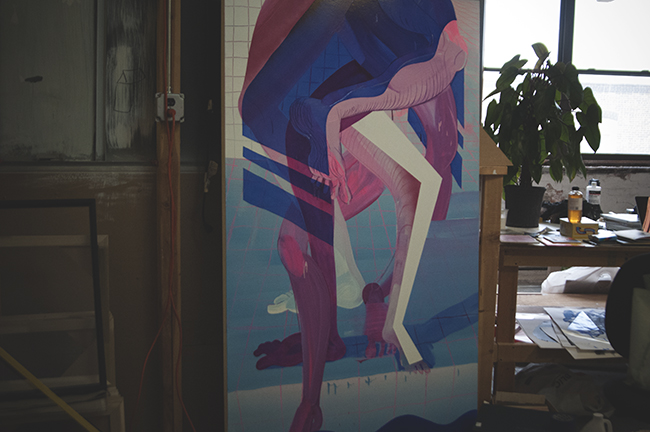
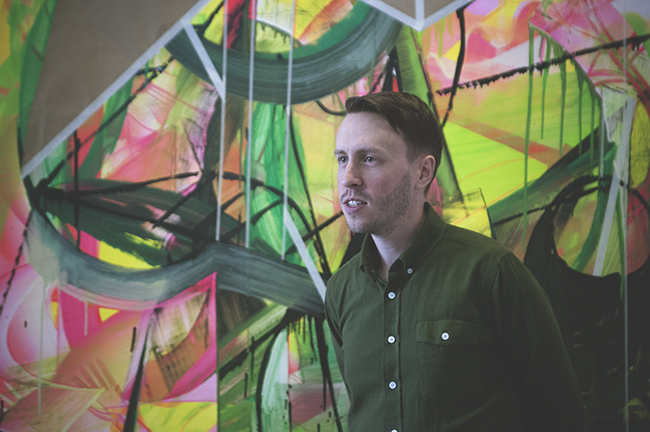
Why did you choose to put yourself in your video, “Shining Shimmering Splendid?”
The videos started out as a way to get more literally performative. My paintings imply performance, this frozen moment of somebody galavanting around a canvas. I was thinking about my interests, and they didn’t just stop at the canvas. I wanted to do something directly, not through a proxy or stand-in. In that video the performance really was getting things from point A to point B, getting things from out of the frame into the frame and set up. It seemed like an embarrassing thing to do, so that’s why I did it. I wanted to be more in the work literally, not hiding behind facility and skill. It seemed like a funny thing to do that would be functional in the video, but could allow for some dry humor as well. It is literally the artist creating the composition in front of your eyes versus your imagined recreation of that person in front of the canvas.
How do your illustration and fine art converse and inform one another?
I am trying to allow my illustration to exist in a world where it doesn’t have to be closeted. I like doing it and I don’t think people really care about you making illustrations and painting too—it’s not a bad thing. I think it’s a relief sometimes to make work, that in the case of a freelance project, isn’t just your idea. You are responding to someone else’s idea and helping it take shape. It is a relief in my own work when I am doing personal illustration, like a comic book, because that needs a more direct narrative. It forces things to clarify a bit for the sake of the story, and you can be a bit more direct. It’s a way to takes these things that I like about painting like color and composition and use them to tell a more narrative story. They are really simple narratives that fall apart into these abstract passages that kind of go back and forth between a clear story and tangential passages. It is liberating to have ways out of your familiarity. It’s nice having a change of pace.


